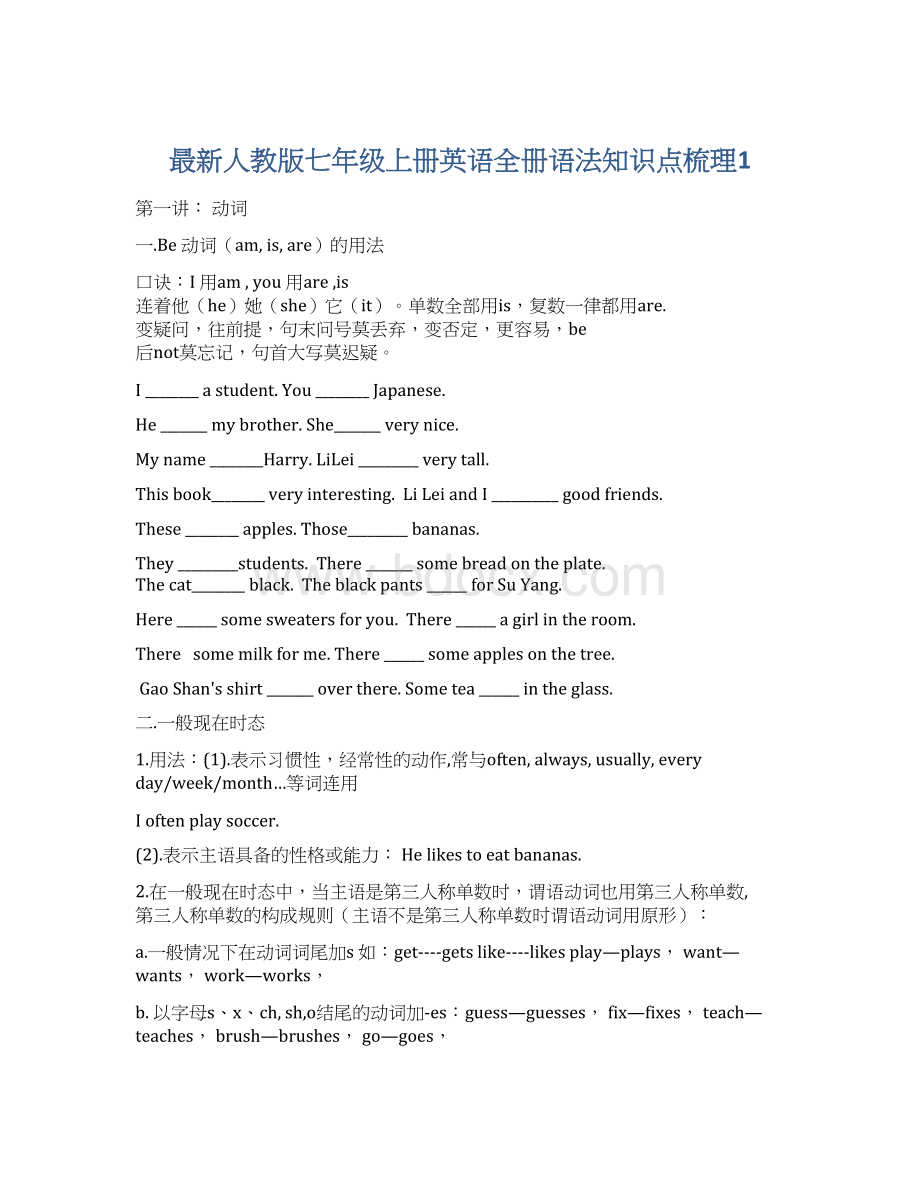最新人教版七年级上册英语全册语法知识点梳理1Word下载.docx
《最新人教版七年级上册英语全册语法知识点梳理1Word下载.docx》由会员分享,可在线阅读,更多相关《最新人教版七年级上册英语全册语法知识点梳理1Word下载.docx(22页珍藏版)》请在冰豆网上搜索。

二.一般现在时态
1.用法:
(1).表示习惯性,经常性的动作,常与often,always,usually,everyday/week/month…等词连用
Ioftenplaysoccer.
(2).表示主语具备的性格或能力:
Helikestoeatbananas.
2.在一般现在时态中,当主语是第三人称单数时,谓语动词也用第三人称单数,第三人称单数的构成规则(主语不是第三人称单数时谓语动词用原形):
a.一般情况下在动词词尾加s如:
get----getslike----likesplay—plays,want—wants,work—works,
b.以字母s、x、ch,sh,o结尾的动词加-es:
guess—guesses,fix—fixes,teach—teaches,brush—brushes,go—goes,
c.以辅音字母+y结尾的动词,先变y为i,再加-es:
study—studies,carry—carries,fly—flies,特殊词:
have----has
一写出下列动词的三单形式。
takelikeplayrundo
watchwisheathavewant
teachstartgostudy
二用所给词的适当形式填空。
1.Weoften
_________(play)intheplayground.2.He
__________(get)upatsixo’clock.
7.
Ateightatnight,she_________(watch)TVwithhisparents.
8
_______Mike
________(read)Englisheveryday?
9.Howmanylessons_________yourclassmate________(have)onMonday?
10.Whattime
_______hismother__________(do)thehousework?
12.She______(have)blueseyes.14.Theboy_________(like)playing
football.
17.It_____(rain)quiteoftenduringthemonthofJulyeveryyear.
19.Mikeusually_________(ride)abikewithhisfriendsinthe
park.
26.We_______(notwatch)TVonMonday.
27.Sandyusually_______(play)thepianoonSundays.
28.Thecat________(like)eatingfisheverymuch.
29.SuHaiandSuYang_______(have)eightlessonsthisterm.
30.SheandI________(take)awalktogethereveryevening.
34.She__________(like)fish,butshe________________(notlike)meat.
第二讲:
代词
(一)人称代词及物主代词(默写出此表格)
人称
第一人称
单数
第二人称
第三人称单数
复数
第三人称
主格
I
you
he
she
it
we
they
我
你
他
她
它
我们
你们
他(她、它)们
宾格
me
him
her
us
them
形容词性物主代词
my
your
his
its
our
their
名词性物主
代词
mine
yours
hers
ours
theirs
我的
你的
他的
她的
它的
我们的
你们的
他(她、它)
们的
一.主格只能作主语;
宾格作宾语
I(主语)amhungry,pleasegiveme(宾语)somethingtoeat.我饿了,请给我一些吃的东西。
主语:
句子要说明的人或事物
Thesunrisesintheeast.太阳从东方升起。
Helikesdancing.他喜欢跳舞。
谓语:
主语的动作、状态和特征,由动词来充当
.WestudyEnglish.我们学习英语2.Heisasleep.他睡着了。
宾语:
动作、行为的对象
.IlikeChina.我喜欢中国。
)2.Youcanhelpme.你能帮助我。
二.形容词性物主代词修饰名词,必须放在名词前面,名词性物主代词相当于名词,后面不能再加名词
用所给词的适当形式填空
1.Thatisnot_________kite.Thatkiteisverysmall,but_________isverybig.(I)
2.Thedressis_________.Giveitto_________.(she)
3.Isthis_________watch?
(you)No,it’snot_________.(I)
4._________ismybrother._________nameisJack.Look!
Thosestampsare_________.(he)
5._________dressesarered.(we)Whatcolorare_________?
(you)
6.Herearemanybooks,whichoneis_________?
(she)
7.Icanfindmytoy,butwhere’s_________?
9.Ihaveabeautifulcat._________nameisMimi.Thesecakesare_________.(it)
10.Arethese_________tickets?
No,_________arenot_________._________aren’there.(they)
11.Shall_________havealookatthatclassroom?
Thatis_________classroom.(we)
12._________ismyaunt.Doyouknow_________job?
_________anurse.(she)
13.Thatisnot_________camera._________isathome.(he)
14.Whereare_________?
Ican’tfind_________.Let’scall_________parents.(they)
15.Don’ttouch_________._________notacat,_________atiger!
(it)
16._________sisterisill.Pleasegoandget_________.(she)
17.________don’tknowhername.Wouldyoupleasetell_________.(we)
18.Somanydogs.Let’scount_________.(they)
第三讲:
名词
(一)名词的分类
名词包括可数名词和不可数名词,可数名词有单,复数之分,单数在前面加a/an来表示
不可数名词没有复数形式,前面也不能用a/an来表示单数。
如:
water,tea,bread,rice,milk,money,time.。
ice-cream,salad,chicken(既可作可数名词,又可作不可数名词)
(二)可数名词复数构成规则
(1)一般情况下在词尾加s..book——books,dog——dogs,pen——pens,boy——boys
辅音结尾的名词后的s的读音为[s],以浊辅音和元音结尾名词后的s读音为〔z〕。
(2)以s,x,ch,sh结尾的词名词变复数时,要在词尾加es.
e.g.beach——beaches,brush——brushes,bus——buses,box—boxes(es读音为〔iz〕
(3)以“辅音字母+y”结尾的名词,先变y为i,再加es.
e.g.city——cities,family——families,documentary——documentaries,country——countries,
(4)以o结尾的名词有生命的词加es如:
.tomato,potato,hero,Negro;
无生命的加s:
.zoo—zoos,radio——radios注:
zero变复数时,既可加s,也可加es:
zeros/zeroes
注:
不规则变化:
.man——men,woman——wome,,Englishman——Englishmen,child——ch